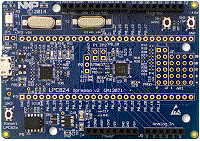LPCXpresso824MAX

-
Core
Cortex-M0+
-
Device
LPC824M201JHI33 -
CMSIS Pack
LPCXpresso824MAX_BSP
-
lpc_adc_burst
Keil Studio AC6, GCC, IARThe lpc_adc_burst example shows how to use LPC ADC driver with the burst mode.In this example, the internal temperature sensor is used to created the input analog signal.When user type in any key from the keyboard,...See more details in readme document.
Download Pack -
lpc_adc_burst
µVision AC6The lpc_adc_burst example shows how to use LPC ADC driver with the burst mode.In this example, the internal temperature sensor is used to created the input analog signal.When user type in any key from the keyboard,...See more details in readme document.
Download Pack -
lpc_adc_dma
Keil Studio AC6, GCC, IARThe lpc_adc_dma example shows how to use LPC ADC driver with DMA.In this example, the internal temperature sensor is used to created the input analog signal. When user type in any key from the keyboard, the software...See more details in readme document.
Download Pack -
lpc_adc_dma
µVision AC6The lpc_adc_dma example shows how to use LPC ADC driver with DMA.In this example, the internal temperature sensor is used to created the input analog signal. When user type in any key from the keyboard, the software...See more details in readme document.
Download Pack -
lpc_adc_interrupt
µVision AC6The lpc_adc_interrupt example shows how to use interrupt with LPC ADC driver.In this example, the internal temperature sensor is used to created the input analog signal. When user type in any key from the keyboard,...See more details in readme document.
Download Pack -
lpc_adc_interrupt
Keil Studio AC6, GCC, IARThe lpc_adc_interrupt example shows how to use interrupt with LPC ADC driver.In this example, the internal temperature sensor is used to created the input analog signal. When user type in any key from the keyboard,...See more details in readme document.
Download Pack -
lpc_i2c_dma_b2b_master
Keil Studio AC6, GCC, IARThe i2c_dma_b2b_transfer_master example shows how to use i2c driver as master to do board to board transfer with DMA:In this example, one i2c instance as master and another i2c instance on the other board as slave....See more details in readme document.
Download Pack -
lpc_i2c_dma_b2b_master
µVision AC6The i2c_dma_b2b_transfer_master example shows how to use i2c driver as master to do board to board transfer with DMA:In this example, one i2c instance as master and another i2c instance on the other board as slave....See more details in readme document.
Download Pack -
lpc_i2c_dma_b2b_slave
µVision AC6The i2c_dma_b2b_transfer_slave example shows how to use i2c driver as slave to do board to board transfer with a DMA master:In this example, one i2c instance as slave and another i2c instance on the other board as...See more details in readme document.
Download Pack -
lpc_i2c_dma_b2b_slave
Keil Studio AC6, GCC, IARThe i2c_dma_b2b_transfer_slave example shows how to use i2c driver as slave to do board to board transfer with a DMA master:In this example, one i2c instance as slave and another i2c instance on the other board as...See more details in readme document.
Download Pack
